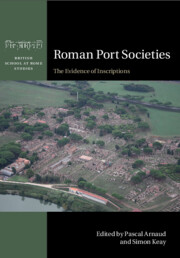Book contents
- Roman Port Societies
- British School at Rome Studies
- Roman Port Societies
- Copyright page
- Contents
- Figures
- Tables
- Contributors
- Abbreviations
- 1 The Context of Roman Mediterranean Port Societies
- 2 Inscriptions and Port Societies
- 3 Stationes and Associations of Merchants at Puteoli and Delos
- 4 Boatmen and their Corpora in the Great Ports of the Roman West (Second to Third Centuries AD)
- 5 Roman Port Societies and Their Collegia
- 6 Port Occupations and Social Hierarchies
- 7 Warehouse Societies
- 8 The Imperial Cult and the Sacred Bonds of Roman Overseas Commerce
- 9 Law and Life in Roman Harbours
- 10 Living Like a Cosmopolitan?
- 11 Ports, Trade and Supply Routes in Western Europe
- 12 The Port Society of Narona
- 13 Municipal Authority, Central Authority and Euergetists at Work at the Port
- 14 The Structure of Mercantile Communities in the Roman World
- 15 Polysemy, Epigraphic Habit and Social Legibility of Maritime Shippers
- 16 Reading Roman Port Societies
- Indexes
- References
9 - Law and Life in Roman Harbours
Published online by Cambridge University Press: 30 October 2020
- Roman Port Societies
- British School at Rome Studies
- Roman Port Societies
- Copyright page
- Contents
- Figures
- Tables
- Contributors
- Abbreviations
- 1 The Context of Roman Mediterranean Port Societies
- 2 Inscriptions and Port Societies
- 3 Stationes and Associations of Merchants at Puteoli and Delos
- 4 Boatmen and their Corpora in the Great Ports of the Roman West (Second to Third Centuries AD)
- 5 Roman Port Societies and Their Collegia
- 6 Port Occupations and Social Hierarchies
- 7 Warehouse Societies
- 8 The Imperial Cult and the Sacred Bonds of Roman Overseas Commerce
- 9 Law and Life in Roman Harbours
- 10 Living Like a Cosmopolitan?
- 11 Ports, Trade and Supply Routes in Western Europe
- 12 The Port Society of Narona
- 13 Municipal Authority, Central Authority and Euergetists at Work at the Port
- 14 The Structure of Mercantile Communities in the Roman World
- 15 Polysemy, Epigraphic Habit and Social Legibility of Maritime Shippers
- 16 Reading Roman Port Societies
- Indexes
- References
Summary
My starting point is a scholarly mess. A few years ago,I came across a very special Latin inscription. Itwas reportedly found ‘pochi anni fa’ (as of 1995) inthe harbour of Rhodes during some reconstruction andenlargement work. It was described as a column ofwhite marble, 220 cm high, with a diameter of 125cm, ‘testimonianza marmorea della lex Rhodia de iactuproveniente da un antico edificio portuale di Rodi’.According to the first editor, the Greek legalscholar Giorgio S. Marcou, it reads, in ‘six orseven lines’ (?): LEX RODIA [sic] CAVETVR (sic) VT (sic) SI LEVANDAE NAVIS GRATIA IACTVS(sic) MERCIVM FACTVM(sic) EST ONIVM(sic) CONTRIBVTIONESARCITVR (sic) QVODPRO OMNIBVS DATVM EST.
- Type
- Chapter
- Information
- Roman Port SocietiesThe Evidence of Inscriptions, pp. 198 - 215Publisher: Cambridge University PressPrint publication year: 2020



